|
|
|
 |
|
"The
spirit of the Lord God is upon me
because the Lord has anointed me
to bring good news to the poor”
ISAIAH 61
|
|
 
It was in the
Nazareth synagogue that Jesus unrolled the scroll of
Isaiah and began to read chapter 61. His
interpretation of the Scripture first astonished and
then angered his neighbors, so much so, that they
conspired to push him off the precipice of the
closely-knit conservative Galilean village.
During our visit to the Nazareth precipice, we
read Luke 4 as we look down into the Jezreel Valley.
Nazareth’s synagogue, however, has not survived the
ravages of 2,000 years. But a scroll of Isaiah
has. It was hidden in a very dry area, in the
cliffs towering over the Dead Sea, some 100 miles
south of Nazareth.
|
|
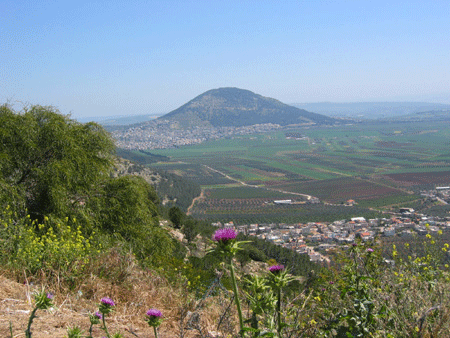 |
|
Photo: Gila
Yudkin |
|
Looking down onto the Jezreel
Valley from the Nazareth precipice |
| |
|
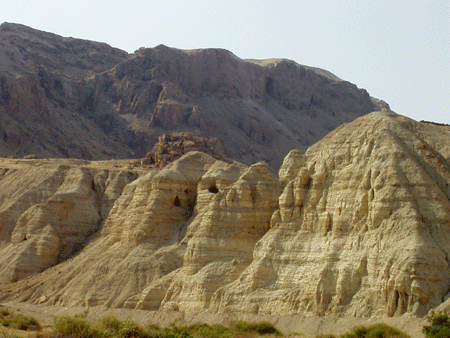 |
|
Photo: Gila
Yudkin |
|
The Judean wilderness above the
Dead Sea where the Isaiah scroll was found |
| |
Of course, it wasn’t
the very scroll that Jesus unrolled, yet we believe
that it’s virtually identical to that scroll.
And as testimony to the scribes’ meticulous
attention in copying Holy Scripture, the
2,000-year-old scroll of Isaiah matches the Hebrew
text transmitted to us over the centuries which we
read and study today in English translation.
Altogether, some 20 copies of Isaiah were found
hidden in caves in the Judean desert. Luckily,
the Judean birds, who loved to stuff their nests
with biblical manuscripts, overlooked one scroll of
Isaiah which was found in its entirety -- with
all 66 chapters. Today, we can inspect a
portion of that Isaiah scroll, on view in
Jerusalem’s Shrine of the Book. The Shrine of
the Book, located in the Israel Museum, has just
reopened after extensive renovations over the past
year to make it more “scroll-friendly.” |
| |
|
 |
|
Photo: Gila
Yudkin |
|
The Shrine of the Book in
Jerusalem has become more "scroll-friendly" |
| |
Our visit opens with
some great photographs documenting the story of the
discovery, identification, dating and preservation
of the scrolls, considered by many scholars to be
the most significant manuscript finding of the
twentieth century.
If you recall, it was a wayward goat that led
shepherds of the Ta’amireh tribe to the cave where
they found leathers inside clay jars. One of
the photographs is of the famed antiquities dealer
Khalil Eskander, nicknamed Kando. With his
trademark cranberry-felt tarbush (hat), Kando
became an icon of the antiquities market, with
one-eyed General Moshe Dayan his most famous
customer.
In the 1980s, when I would bring pilgrims keen on
collecting antiquities to his shop, not far from the
Garden Tomb, Kando would allow serious buyers to
take his photograph. Afterwards, his sons
would lead us up to the loft, where we could
actually touch two of the original jars, those he
hadn’t sold. I have to admit, the first time I
touched a jar which had stored the
two-thousand-year-old leather manuscripts, I felt
goose bumps and chills up my spine.
Besides Kando, the photo collection includes other
famous personalities of the Dead Sea Scroll saga:
the Metropolitan (archbishop) of the Syrian Orthodox Church who
bought the first scrolls, Professor Eleazar Sukenik
who first realized their antiquity, Professor
Biebenkraut, a restorer of old paintings in pre-Nazi
Germany, who figured out how to unroll the scrolls
without destroying them, J.C. Trevor of the American
School of Archeology who was the first to photograph
the Isaiah scroll, and the team of 8 international
scholars who worked in the “Scrollery” at the
Rockefeller Museum opposite the Old City’s Flowers
Gate to decipher and interpret the content of the
scrolls. |
| |
|
 |
|
Courtesy of the
Israel Antiquities Authority |
|
The "Scrollery" at the Rockefeller
Museum where the Dead Sea Scroll
fragments were sorted and studied |
| |
As we walk towards
the main exhibition area, we see artifacts found at
Qumran, belonging to the ancient community whom most
scholars believe were Essenes, a group of protestors
against the Jerusalem Temple leadership and
practices. This is the way they interpreted
Isaiah 40:3: “A voice is crying out, ‘IN THE
WILDERNESS PREPARE THE WAY FOR THE LORD’.” So,
there they were, like birds in the wilderness, a
mere five miles from the center of John the
Baptist’s ministry, waiting for redemption.
Artifacts include a calendar, sundial, oil lamp with
original wick, combs, beads, charred dates,
fragments of a prayer shawl, and first century BC
coins. One of the minutest finds exhibited is
a collection of sandal nails found in 1995 on the
surface of trails leading from Qumran up to the
caves. Some scholars believe that this “nails”
the theory that the people in the settlement we call
Qumran were the ones who not only hid, but also
wrote the scrolls. |
| |
| |
| The first
excavator at Qumran, Father Roland de Vaux,
surmised that most of the sect members lived
in the surrounding caves and came to the
motherhouse at Qumran to dine and serve God.
The 1995 excavators Hanan Eshel and Magen
Broshi (retired curator of the Shrine of the
Book) found some 60 iron nails from sandals
worn 2,000 years ago as well as first
century AD coins and broken pottery,
attesting to substantial foot traffic
between the caves and the settlement at
Qumran. |
| |
|
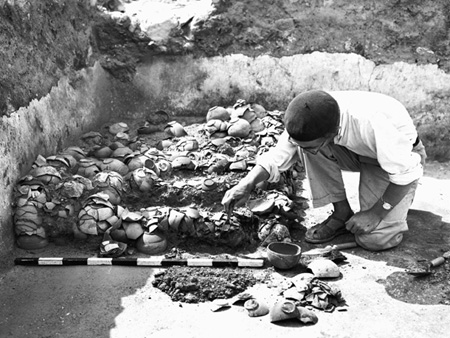 |
|
Courtesy of
the Israel Antiquities Authority |
|
Excavator Roland de Vaux
examining plates, bowls and goblets at
Qumran |
| |
Moving into
the “shrine,” the most important exhibit
displays a section of the Isaiah Manuscript
1, the Isaiah scroll of 17 leather sheets,
intact with all 66 chapters.
Isaiah Manuscript 1 is one of the four
scrolls originally bought by the
Metropolitan in July 1947 for $97.20.
Seven years later, in June 1954, in an
advertisement appearing in the Wall Street
Journal, the Metropolitan offered to sell
all four scrolls. Closing a circle,
the son of Professor Eleazar Sukenik, Yigael
Yadin, then on the U.S. lecture circuit as
an archeologist, purchased the four scrolls
for the State of Israel for the nifty sum of
$250,000.
After fifty years of display, we are
challenged to preserve the Dead Sea scrolls
for future generations. Originally,
the scrolls were displayed upright which
caused the parchment to become damaged.
Starting in 1997, each scroll fragment
underwent special treatment which included
thorough cleaning, flattening and mending
with Japanese tissue.
The Shrine of the Book is presently
experimenting with a new showcase using
optic lighting and positioning the scrolls
at an angle of no more than 35 degrees.
Scrolls on display are rotated every three
to six months, with a different leather
parchment of Isaiah being exhibited each
time.
The existence of the 2,000-year-old Isaiah
scroll is a tribute to the religious devotion of
the community and the prodigious skill and
love of beauty exemplified in the scribes’
calligraphy. Comparison of the Qumran
Isaiah with the earliest traditional
Masoretic which is ONE THOUSAND YEARS LATER
proves the antiquity and authority of the
Bible we read today.
On your next visit to the Holy Land, come
with me to the Shrine of the Book to inspect
a portion of the ancient Isaiah, similar to
the scroll unrolled by Jesus in his hometown
synagogue.
|
|
Copyright 2005, 2009 Gila Yudkin.
Permission needed for any reuse. |
|
|
|
While guiding pilgrims throughout the Holy
Land for more than a quarter of a century,
Gila
Yudkin has closely followed the
drama of the Dead Sea Scroll saga. She
relishes showing how archeology has
enlightened us on so many biblical passages.
Although she considers herself a liberal,
she laughingly agrees with one of her
favorite Baptist pastors who likes to
proclaim, “Every time an archeologist turns
over a spade, he buries another liberal!” |
|
|
|
More on the Dead Sea Scrolls: |
|
|
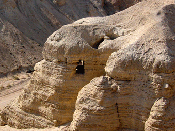 |
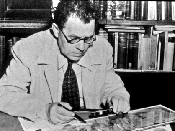 |
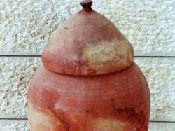 |
| Cave
number 4 at Qumran |
Eleazar Sukenik |
Original jar still
held by Kando |
|
|
|
|
More on biblical archeology: |
|
|
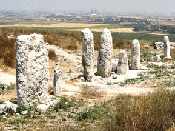 |
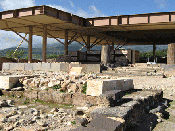 |
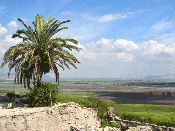 |
| Gezer &
Solomon's wife |
Hazor & Joshua |
Megiddo
& Solomon's Stables |
|
|
|
|
Postscript Just after I sent out
this highlight, I was at the Shrine of the
Book, explaining the significance of ritual
objects found at Qumran, when a participant
on our pilgrimage nearly knocked my socks
off. Joseph Caulfield from Mount Vernon,
Washington stood in front of a showcase,
pointed to an ostracon (an inscribed pottery
shard) and proclaimed, "Hey, folks, I found
this piece.” The pottery shard, written in
Hebrew, is dated to the second year of the
revolt (67 AD). |
|
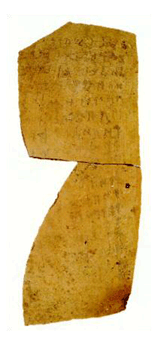 |
Joseph was a volunteer at the 1996 Qumran
dig led by Dr. James F. Strange. The area
being excavated was too crowded with
diggers, so Joseph decided to tackle more
virgin territory. “I heard a clink as the
trowel hit a pottery shard which flew about
two feet forward,” remembers Joseph. “I
picked it up and when I rubbed off some
dust, I noticed the writing.” When Joseph
brought Dr. Strange to the place where he
found it, another volunteer, an 80-year-old
woman, kicked at the dirt, and asked, “Was
it like this one?” This second ostracon fit
perfectly with the one Joseph discovered.
The ostracon, the first piece of writing to
be recovered from Qumran since the site was
excavated in the middle of the last century,
was broken at a critical point. Scholars
disagree as to the proper reading |
|
Qumran
ostracon |
of one letter which completely changes |
|
Joseph Caulfield found the
top piece |
the meaning of the nature of the |
|
|
transaction. |
|
Frank Moore Cross of Harvard University and
Esther Eshel of Hebrew University believe
that the ostracon records a gift of property
in Jericho to the Essene community at
Qumran. The community did not allow private
ownership of property. On the other hand,
Israeli paleographer Ada Yardeni (who first
identified the “Priestly
Benediction” on the silver
amulets found by St Andrew’s Church)
suggests that the ostracon records an
ordinary land transaction.
“The first time I saw the ostracon exhibited
at the Shrine of the Book, I thought, ‘Whoa,
that’s mine – I found it. It was way cool’,”
says Joseph. “Especially knowing that the
find helps scholars better understand life
at Qumran two thousand years ago.” |
| |
| See
Gila’s
Recommended Holy Land Books for a
thrilling read on the controversy
surrounding the scrolls and a neat
literary travelogue on the history, politics and
myths of the Dead Sea. |
| |
|
Copyright 2005, 2009 Gila Yudkin. Permission
needed for any reuse. |
| |
Coming to Jerusalem
soon? Would you like to find the venues
where you can
quietly be transported back in your imagination to
the
time of Jesus? Isaiah? David? Abraham?
Make every minute matter while you "Explore
Jerusalem's Soul" with
Gila's Unorthodox Guide.
This updated PDF (Adobe Acrobat) 46-page guide
gives you ten places to meditate on the
Bible, lesser-known churches, most rewarding roof-top
views and the top ten places for sampling Middle Eastern
food. And some are within walking distance
of the Isaiah Scroll at the Israel Museum! More
on
Gila's Jerusalem Guide....
|
|
|
|
GILA
YUDKIN
•
TCHERNIKOVSKI
64A
•
JERUSALEM
•
ISRAEL
gila@itsgila.com
HOME
•
BOOK
GILA
•
TIPS
FOR TOURS •
ABOUT GILA
|
|

